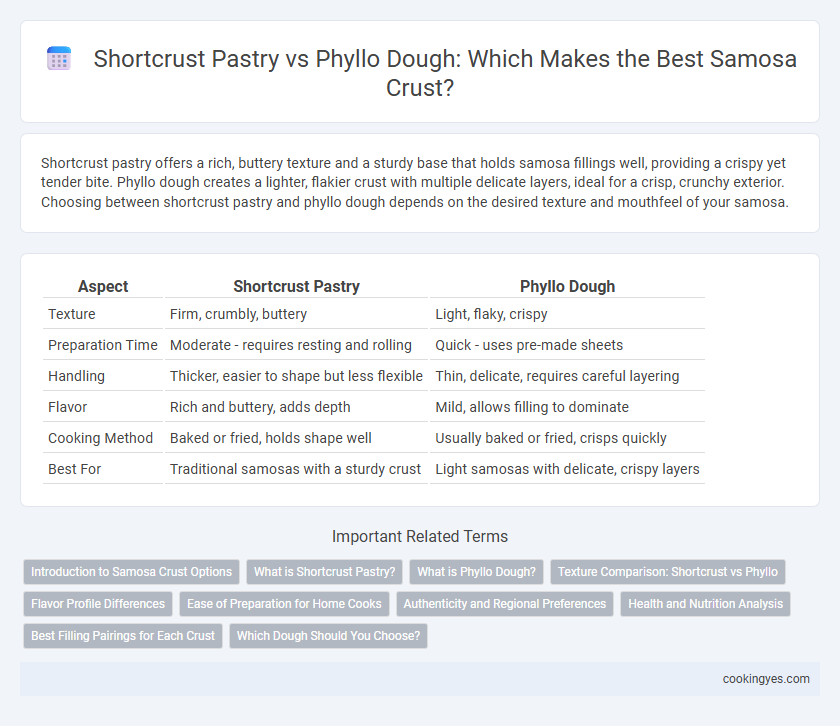Shortcrust pastry offers a rich, buttery texture and a sturdy base that holds samosa fillings well, providing a crispy yet tender bite. Phyllo dough creates a lighter, flakier crust with multiple delicate layers, ideal for a crisp, crunchy exterior. Choosing between shortcrust pastry and phyllo dough depends on the desired texture and mouthfeel of your samosa.
Table of Comparison
| Aspect | Shortcrust Pastry | Phyllo Dough |
|---|---|---|
| Texture | Firm, crumbly, buttery | Light, flaky, crispy |
| Preparation Time | Moderate - requires resting and rolling | Quick - uses pre-made sheets |
| Handling | Thicker, easier to shape but less flexible | Thin, delicate, requires careful layering |
| Flavor | Rich and buttery, adds depth | Mild, allows filling to dominate |
| Cooking Method | Baked or fried, holds shape well | Usually baked or fried, crisps quickly |
| Best For | Traditional samosas with a sturdy crust | Light samosas with delicate, crispy layers |
Introduction to Samosa Crust Options
Samosa crust options primarily include shortcrust pastry and phyllo dough, each offering distinct textures and flavors. Shortcrust pastry provides a rich, crumbly base with a buttery taste that complements savory fillings, while phyllo dough delivers a flaky, crispy layer enhancing the samosa's crunch. Selecting the right dough influences the overall eating experience, balancing between tenderness and crispiness.
What is Shortcrust Pastry?
Shortcrust pastry is a type of dough made from flour, fat (usually butter or ghee), and a small amount of water, resulting in a tender and crumbly texture ideal for samosa crusts. Unlike phyllo dough, which is paper-thin and crisp, shortcrust pastry provides a sturdier, more substantial shell that holds the filling firmly without becoming overly flaky. Its rich, buttery flavor enhances the savory fillings commonly used in samosas, making it a popular choice for a satisfying and indulgent snack.
What is Phyllo Dough?
Phyllo dough is a paper-thin, unleavened dough traditionally used in Mediterranean and Middle Eastern cuisines, prized for its crisp, flaky texture when baked or fried. Unlike shortcrust pastry, which is rich and crumbly due to its higher fat content, phyllo dough consists primarily of flour, water, and a small amount of oil, offering a lighter and more delicate samosa crust. Its multiple layers create a crunchy exterior that contrasts with the savory filling, making it a popular choice for samosas seeking a crispier bite.
Texture Comparison: Shortcrust vs Phyllo
Shortcrust pastry provides a dense, crumbly texture that holds fillings firmly, creating a rich, buttery experience for samosas. Phyllo dough, in contrast, offers a delicate, flaky crispness with multiple thin layers that produce a light and crunchy shell. The choice between shortcrust and phyllo significantly influences the overall mouthfeel, with shortcrust delivering a hearty bite and phyllo emphasizing a crispy, airy texture.
Flavor Profile Differences
Shortcrust pastry offers a rich, buttery flavor with a tender, crumbly texture that complements the spicy filling of samosas, enhancing its savory depth. Phyllo dough provides a lighter, flakier crust with a subtle, slightly nutty taste that allows the filling's spices to stand out more prominently. Choosing between shortcrust and phyllo dough impacts the overall flavor experience, with shortcrust delivering a hearty richness and phyllo contributing a crisp, delicate layer.
Ease of Preparation for Home Cooks
Shortcrust pastry offers a straightforward preparation process for samosa crust, requiring basic ingredients like flour, butter, and water, making it accessible for home cooks. Phyllo dough, though lighter and flakier, demands careful handling and multiple layers, which can be challenging for beginners. Home cooks seeking simplicity often prefer shortcrust pastry due to its forgiving nature and ease of shaping.
Authenticity and Regional Preferences
Shortcrust pastry offers a rich, buttery texture that aligns with traditional North Indian samosa recipes, prized for their robust and flaky crust. Phyllo dough, lighter and crispier, is preferred in regions like Kashmir and parts of the Middle East, providing a delicate crunch that complements spiced fillings. Authentic samosas often reflect regional preferences, with shortcrust favored for hearty, savory fillings and phyllo chosen for lighter, layered textures.
Health and Nutrition Analysis
Shortcrust pastry used in samosas typically contains higher amounts of butter or shortening, resulting in increased saturated fat and calorie content compared to phyllo dough, which is made with minimal oil and has a lower fat profile. Phyllo dough offers a lighter, crispier texture while providing fewer calories and less fat, making it a healthier option for those mindful of heart health and weight management. Nutritionally, samosas made with phyllo dough have reduced cholesterol and saturated fat levels, contributing to better cardiovascular benefits without compromising flavor.
Best Filling Pairings for Each Crust
Shortcrust pastry pairs best with hearty fillings like spiced potatoes, peas, and minced meat due to its robust, crumbly texture that holds dense mixtures well. Phyllo dough complements lighter fillings such as sauteed vegetables, paneer, and herbs, providing a crisp, flaky shell that enhances delicate flavors. Choosing the appropriate crust enhances the samosa's overall texture and taste, optimizing the balance between filling moisture and pastry crispness.
Which Dough Should You Choose?
Shortcrust pastry offers a rich, buttery texture that enhances the samosa's flavor with a tender, crumbly crust, ideal for those seeking a traditional and hearty bite. Phyllo dough creates a light, flaky, and crispy shell, perfect for a delicate texture that crisps beautifully during frying or baking. Choose shortcrust pastry for a robust, dense crust or phyllo dough for an airy, crunchy samosa experience.
Shortcrust Pastry vs Phyllo Dough for samosa crust Infographic

 cookingyes.com
cookingyes.com